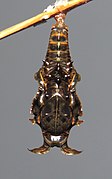Athyma ranga
| Athyma ranga | ||||||||||||
|---|---|---|---|---|---|---|---|---|---|---|---|---|

Athyma ranga |
||||||||||||
| Systematics | ||||||||||||
|
||||||||||||
| Scientific name | ||||||||||||
| Athyma ranga | ||||||||||||
| ( Moore , 1857) |
Athyma ranga is occurring in Asia Butterfly ( butterfly ) from the family of Nymphalidae (Nymphalidae) and the sub-family of kingfishers (Limenitidinae).
features
butterfly
The wingspan of the moth is 60 to 75 millimeters. There is no sexual dimorphism between the sexes , males and females have the same drawing elements . The basic color of the upper sides of the wings is black and, depending on the incidence of light, sometimes shimmers from a greenish to bluish tinge. A band made up of white spots extends over the disk region . Another single white spot is in the cell on the top of the forewing. The submarginal region of the upper side of the hind wing is slightly lightened, the fringes are alternately black and white piebald. On the dark brown undersides of the wings a very distinctive white pattern of spots stands out. The blackish abdomen is provided with white spots on the sides.
Pre-imaginal stages
The egg has a greenish color and a spherical shape. It is covered with hexagonal dimples over the entire surface from which short light hairs protrude. The base is slightly flattened. The diameter is around 1.5 millimeters.
The caterpillars hatch three to four days after laying eggs. In their first stage they are predominantly brownish in color and provided with short tubercles , which transform into branched thorns in the second stage and take on an elongated shape in the third and fourth stage. The fully grown caterpillar reaches a length of about three centimeters, is grass green in color and shows a wide whitish, belt-like stripe in the middle.
The pupa is predominantly silver in color, shows dark wing sheaths shortly before the moths hatch and has several horn-like outgrowths on the back and back of the head. It is attached to branches or leaves as a falling doll .
Distribution, subspecies and habitat
The species occurs widely in India , Thailand , Malaysia , Myanmar , Nepal and southeast China . Five subspecies are currently classified in the various occurrence areas . Athyma ranga prefers to colonize evergreen deciduous forests as well as moist forest edges. The altitude distribution ranges in locations of up to 2000 meters.
Way of life
The moths fly in several generations a year from April to December , four generations have been recorded in Hong Kong . The last generation of the year overwinters in the pupal stage. The moths very seldom visit flowers to eat, but sometimes take in liquids and minerals in damp places in the earth or excrement. The caterpillars feed polyphagously , preferably on the leaves of the olive family (Oleaceae) or honeysuckle family (Caprifoliaceae).
Individual evidence
- ↑ a b c James J. Young: A brief note on the life history of Athyma ranga (Moore) Lepidoptera: Nymphalidae in Hong Kong In: Hong Kong Lepidopterists' Society Limited, 2004 (accessed from http://old.hkls.org /info-a_ranga.html on March 4, 2018)
- ↑ Markku Savela: Tanaecia Butler (1869) - distribution. In: Lepidoptera and some other life forms. Retrieved March 4, 2018 .
Web links
- ifoundbutterflies - Butterflies of India
- indiabiodiversity - India Biodiversity Portal
- learnaboutbutterflies - Blackvein Sergeant
- eol.org - Encyclopedia of Life




